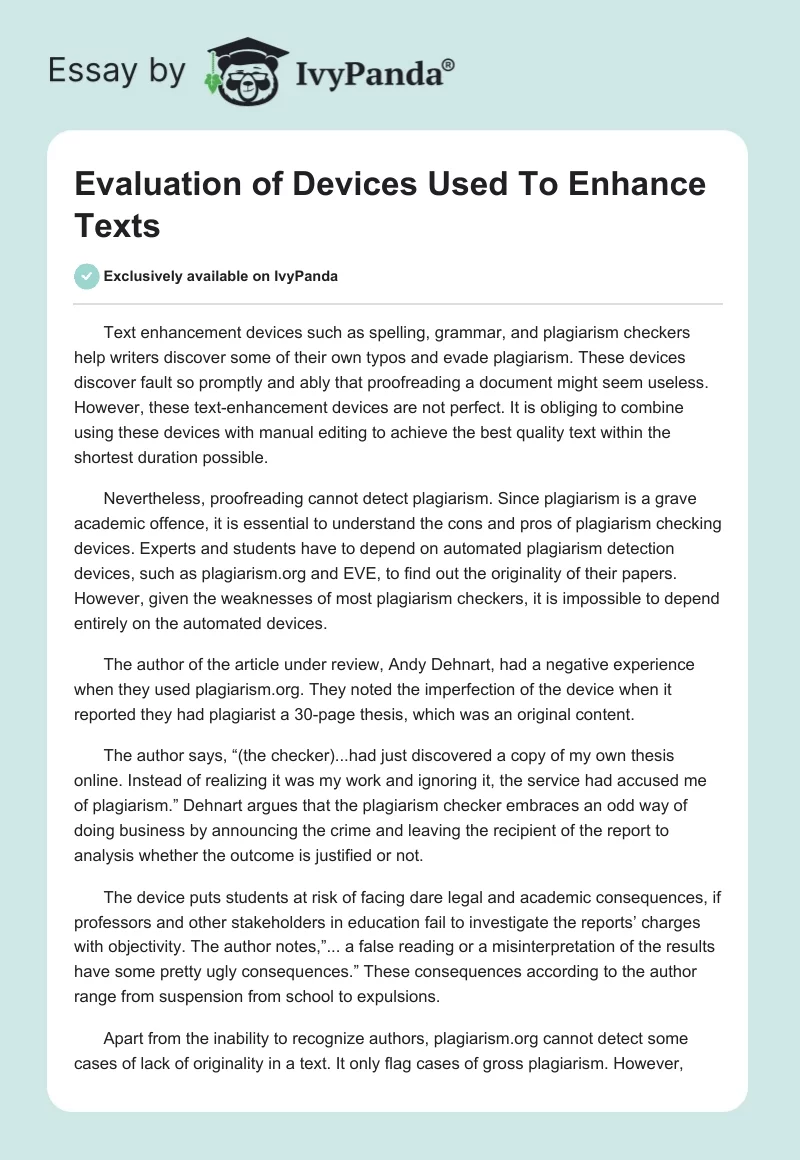Text enhancement devices such as spelling, grammar, and plagiarism checkers help writers discover some of their own typos and evade plagiarism. These devices discover fault so promptly and ably that proofreading a document might seem useless. However, these text-enhancement devices are not perfect. It is obliging to combine using these devices with manual editing to achieve the best quality text within the shortest duration possible.
Nevertheless, proofreading cannot detect plagiarism. Since plagiarism is a grave academic offence, it is essential to understand the cons and pros of plagiarism checking devices. Experts and students have to depend on automated plagiarism detection devices, such as plagiarism.org and EVE, to find out the originality of their papers. However, given the weaknesses of most plagiarism checkers, it is impossible to depend entirely on the automated devices.
The author of the article under review, Andy Dehnart, had a negative experience when they used plagiarism.org. They noted the imperfection of the device when it reported they had plagiarist a 30-page thesis, which was an original content.
The author says, “(the checker)…had just discovered a copy of my own thesis online. Instead of realizing it was my work and ignoring it, the service had accused me of plagiarism.” Dehnart argues that the plagiarism checker embraces an odd way of doing business by announcing the crime and leaving the recipient of the report to analysis whether the outcome is justified or not.
The device puts students at risk of facing dare legal and academic consequences, if professors and other stakeholders in education fail to investigate the reports’ charges with objectivity. The author notes,”… a false reading or a misinterpretation of the results have some pretty ugly consequences.” These consequences according to the author range from suspension from school to expulsions.
Apart from the inability to recognize authors, plagiarism.org cannot detect some cases of lack of originality in a text. It only flag cases of gross plagiarism. However, some checkers flag legitimate excerpts, as well. ” But a quick check showed that the indicated sentences were all legitimate excerpts…with quotation marks and citing sources.” Dehnart says. The inability to detect whether the author has cited a text properly is a common weakness of most text enhancing devices.
However, despite the weaknesses of the plagiarism-checking device, it also plays a crucial role in enhancing texts. Experts say that plagiarism.org is an effective informational tool that enables professors to find out whether students use quotation marks properly.
It also helps professors to evaluate the percentage of text that the student has directly quoted from other sources. Using manual methods of searching through files has been prohibitively time-consuming. When professors use the automated device properly, they save time and detect levels of plagiarism that human efforts alone cannot detect.
Plagiarism.org contributes significantly to the reduction of academic cheating cases. According to creators of plagiarism.org, the device has discouraged students from downloading and submitting to professors their peers’ work as their own.
Given the scope of success of the device regarding stopping or reducing cheating cases in schools, the technological tool is a solution to the challenge the Internet was breeding. The effectiveness of the plagiarism checker has led to the increase in popularity of the technology. The author of the article under review states,” To date, (the checker)… has been used … by hundreds of individual instructors around the globe.”
Additionally, plagiarism.org is useful for verify whether a student has cheated. According to the author, when students understand that there are mechanisms for detecting plagiarism, they work hard to generate original content and avoid punishment. The use of the checker makes it easy for students to confess if they have presented another person’s work.
Apart from plagarism.org, EVE is another commonly used text enhancement device. It is also imperfect. Despite that the device offers exceptional searching power, it lacks usability and interface. The software cannot provide side-by-side comparison on a paper and match texts it locates from other sources. It provides URLs for sites where it has found matching materials. EVE leaves the task of determining what the author actually plagiarised to the user.
Spelling and grammar checkers also have problems. They do not recognise some proper nouns and the meaning of words or sentences in context. Further, they do not remove negative words even if their use changes the meaning of the sentence to what the user never intended. Spell-check and grammar-check devices do not teach spelling and grammar concepts.
Notably, all automated grammar, spelling, and plagiarism-checking devices only improve text if the user understands what they want. Professors should evaluate and interpret reports that these devices generate.
In the case of the paper that the author of the article submitted, there was no plagiarism. If the professor had no competence on plagiarism detection, the college would have expelled the student from school. Therefore, despite the essentiality of text enhancement devices, nothing can entirely substitute the observant eyes of human beings.


